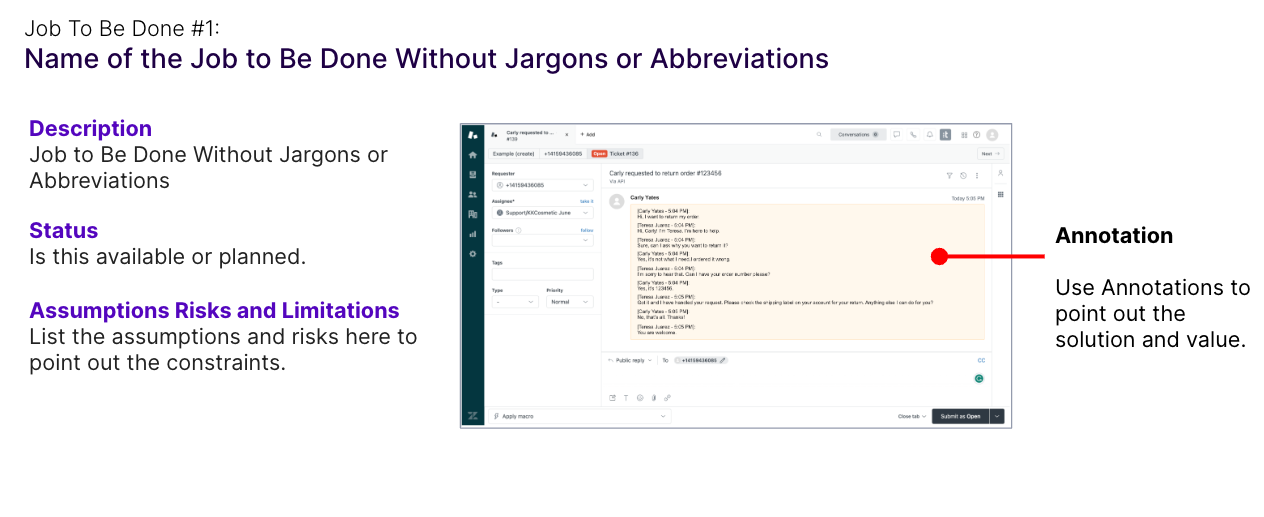Jobs Definition Document (JDD)
A tool to help product managers and customer success managers turn customer escalations into stronger relationships.
The Role of a Jobs Definition Document (JDD) in Managing Enterprise SaaS Customers
In enterprise SaaS, product managers often face escalations from dissatisfied customers that can jeopardize revenue, renewals, and customer loyalty. These high-stakes issues often reach sales or executive teams due to their potential impact on business metrics. To address these situations systematically, product managers can leverage a Jobs Definition Document (JDD) as a structured tool to capture and communicate customer needs and align internal teams. The JDD uses the Jobs-To-Be-Done framework. Let’s have a brief look at that framework.
Introduction to the Jobs-to-be-Done Framework(JTBD)
Theodore Levitt famously said that. “People don’t want a quarter-inch drill. They want a quarter-inch hole!”. Unfortunately, customers, particularly, ones that are dissatisfied or anxious do not always state what they want to accomplish. Instead they say what they want usually based on another tool they used or a process they followed before.
The Jobs-to-be-Done (JTBD) framework, pioneered by Professor Clayton Christensen, emphasizes understanding the underlying “job” a customer is trying to accomplish rather than focusing only on product features. By focusing on the customer’s desired outcome, product teams can design solutions that better address real customer needs.
The Purpose of a Jobs Definition Document
A Jobs Definition Document (JDD) is a collaborative artifact between internal teams and the customer, capturing a clear, actionable understanding of the customer’s business context and the specific “jobs” they need to accomplish. It enables product managers to:
Clarify Critical Jobs: Define and prioritize the tasks a customer is trying to achieve.
Align on Capabilities: Detail current product capabilities that address these jobs and identify gaps.
Manage Stakeholder Expectations: Create transparency on what is feasible, setting realistic expectations for both internal teams and the customer.
Key Benefits of a JDD
The JDD offers two primary benefits in managing customer escalations:
Internal Alignment: Brings all stakeholders—product, engineering, sales, and customer success—onto the same page, fostering a unified understanding of the customer’s problem and planned response.
Clear Customer Communication: Equips the product leader to articulate how the product addresses specific customer jobs, creating a shared vision and a constructive execution plan.
Components of a JDD
A well-structured JDD typically includes these sections:
Business Scenario: A concise overview of the customer’s environment to provide context. The person who is in touch with the customer can provide this overview. This is usually the customer success manager or account manager.
Customer Jobs-to-be-Done: A list of the main outcomes the customer seeks to achieve.
Status of Capabilities: An evaluation of current capabilities that support the customer’s jobs and any identified gaps.
Jobs Overview: A one-slide summary for each job, including:
Job Name and Description
Diagram: Visual representation of the job and related steps
Assumptions, Risks, and Limitations: Any constraints impacting the solution.
Next Steps: Defined action items for follow-up and resolution.
Format and Timing
Given that the JDD is both an internal and external communication tool, a concise slide presentation format works well, allowing product managers to present effectively in brief sessions.
When to Create a JDD?
A JDD is typically created when a product leader identifies an unmet or critical customer need that current support workflows cannot resolve. It’s especially useful in escalations that highlight larger gaps in product capability or customer understanding.
Who creates a JDD?
Product managers create the JDD with inputs from the customer success manager or account executives.
Important Distinction
A JDD is not a legal document or a Statement of Work; it is a discussion tool to clarify jobs and align on solutions.
This is not a roadmap presentation document. If there are jobs that cannot be supported by the product, it is important to point that out.
By using a JDD, product managers can turn escalations into opportunities to deepen customer relationships and demonstrate the product's relevance, fostering trust and long-term loyalty.
Note: If you would like a template, please leave a comment. I will create one.




